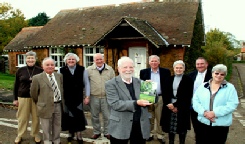The Manorial Court
The Manorial Court which began early in the history of the Manor served as a local legal and administrative system. It arose from the pre-Norman custom of frankpledge which was a system of mutual responsibility, where every male householder formed one of a group of 10 or 12 people responsible for the good behaviour of one another and for bringing its members to the manorial court to face charges if necessary. In the ancient charter of the Manor of Castle Rising, William D’Albini and his successors were granted “ffrancyplege in the Townes adioyning unto the Castle”. The responsibility of the Lord of the Manor was to organize the life of the estate for his own profit and to protect the rights of the local inhabitants. The manorial court dealt with such matters as the transfer of land, the organization of the communal agriculture, the abatement of nuisances (defective hedges, blocking of paths, straying beasts, etc) and anything else concerning minor disputes or misdeeds of the inhabitants. The Manorial Court was usually divided into two different entities. These were the Court Baron, which dealt with the transfer of copyhold land upon inheritance or sale, and the Court Leet, which dealt with petty law and order and the administration of communal agriculture.
In general all male members of the parish aged 12 years or older were required to attend the Manorial Court or to provide a reason for non-attendance (called an essoin). Missing the court for three successive occasions could result in a fine. As stipulated by the Magna Carta, the courts convened twice a year, normally within a month after Easter and again within a month after Michaelmas (29 Sept.). The Court Leet in the Manor of Castle Rising however, for the period covered by existing records, was held only once a year, after Michaelmas.
The practice of keeping manorial court records began in the second half of the thirteenth century and we are fortunate in that the records from 1642 until 1922 for the parishes of Castle Rising, Roydon and North Wootton have survived and have been preserved in the Norfolk Record Office. Without the timely intervention of Bradfer-Lawrence, these books may have been unavailable to the historian. A pencilled note by him in the front of Book 2 (Liber B) containing the records from 1653-64 states “This volume was missing for many years and thought to be lost. Messrs T. Archer and W.D Wood, the stewards immediately before me had never seen it or knew of its existence. I found it quite by accident in a box of old estate papers recorded for the Stables at the Hall at Castle Rising. H.L.Bradfer-Lawrence Steward of the Manor 27th January 1926.”
The first book (from 1642-1653) was in a particularly poor state of repair and only careful and extensive restoration by the NRO has recently made it accessible to the historian. Earlier records for the years 1558-67and 1604-05 exist in the archives at Arundel Castle, but we have not seen these. Transactions continued to be recorded in the manor court book until the abolition of copyhold land by the Law of Property Act of 1922. The series of court books from 1642 to 1922 provide a fascinating glimpse of village life from the mid-seventeenth to the nineteenth century. They not only give the names of most of the adult male residents of the village but also tell us something of the agricultural life of the village and the customs of earlier times. Most records were written in Latin until 1732, but during part of the Commonwealth period they were in English.
The business of both the Courts Baron and the Courts Leet were recorded. In the seventeenth century, they were generally recorded separately, with different members of the parish attending each court. As expected, only the men of the village attended the manorial courts. Usually only 3 or 4 people attended the Court Baron, which dealt with transfers of copyhold leases usually on the death of a previous copyholder. Although the names of the past and future copyholders were recorded, there are few descriptions of the properties themselves. However a careful examination of the Court Baron records could probably allow the individual burgages to be identified and matched with present-day properties or sites.
At the Court Leet, attendance was higher, usually between 12 and 25 and the average between the years 1642 and 1835 was 15. It rose slightly to an average of 18 in the reign of Charles II, possibly a reaction to the end of the Commonwealth period. In the court book of 1666, five years after the restoration of the Monarchy there is a complete list of all the men who were required to attend the Castle Rising Court Leet. This was broken down into 3 categories; those who did attend (15), those who provided essoin (excuse for non attendance) (46) and those who defaulted (5). This suggested that the village at that time had a male population (above the age of 12) of 66 and by extrapolation a total population of around 200-250 people. This seems to be a smaller population than at the time of Domesday. Not all manors expected boys to attend as early as the age of twelve, but in Castle Rising we know from a comparison of baptism records and first Court Leet attendance that at least one boy attended at the age of 12. Some attended on more than 30 occasions, others less frequently, and some names never appeared at all. Their signatures (or more commonly their marks) recorded their attendance and give a good idea of their involvement in the village. Often sons went along with their fathers and in time took over some of the duties of their fathers. Although the number of attendees remained similar throughout the time, the proportion of the men of the village who attended declined as the village population increased. One imagines that in the later years the Court Leet had less to do with the business of the village and was more an occasion for the men of the village to get together and go off after the proceedings to one of the several drinking establishments in the village. Charles Feltwell, the tenant of the Blue Parlour to the south-east of the Market Green attended the Court Leet sixteen times from 1732 to 1759 and was no doubt happy to have the business.
According to Hardy (1984), in sixteenth century England both Court Baron and Court Leet were reasonably thriving institutions but by the end of the century this was no longer so and the history of manorial courts was “one of gradual but unrelenting decay”.. In the early years the Court played an important part in the organization of Castle Rising but over time it became increasingly formalistic. The minutes of the Court Leet however do provide a useful insight into the local scene. . It was held annually (occasionally more often if there was urgent business, such as the death of a Mayor), usually around the end of October or early November. It sometimes took place in the parish church but a quotation in 1823 (Norfolk Annals Vol. 1) reports “in the great hall [of the castle] where the Court Leet is held”. In the nineteenth century it was occasionally held in the school-house. The two main items of business were to elect the officials of the parish and to oversee the management of the Commons. The officials elected included the Mayor, a Sergeant-at-Mace, two Constables (who were also Dyke-reeves) and a Hog-ringer or Pinder. According to Bradfer-Lawrence, in former times two aldermen were also elected. The actual decision of who should be Mayor was presumably determined by the Lord of the Manor, and for many years the choice alternated between someone nominated by the Howards and the Walpoles. Nevertheless the formal declaration of who was to be the Mayor for the year was made at the Court Leet and the Mayor was expected to read the Mayoral Oath which is recorded at the beginning of the Court Records for 1688-1728 In an example of eighteenth century nepotism the Sergeant-at-arms was sometimes the son of the Mayor. In 1741 William Butter was Mayor and William Butter junior his Sergeant-at-Mace.
The other major business of the Court Leet was to oversee the management of the Common land. In previous centuries the leet presumably organised the distribution of land in the common ridge and furrow fields such as the one which was located inland from the pre-Norman sea-wall, but there is no evidence of this in the years for which we have records. Although the precise boundaries of the Commons changed over time, in general we have a good idea of their locations both from the 1588 and 1732 maps and from an understanding of the present vegetation. The main areas were the Day Marsh and the Night Marsh, which occupied the area of low land to the north and north-east of the village. In earlier times they were located on both sides of the Babingley River above and below the stone bridge, but appear to have contracted by the nineteenth century. These areas were, as their names suggest, grazing marshes but they also provided peat for heating the homes.
Bradfer-Lawrence HL (1932) Op cit. p128
Denis Stuart (1992) Manorial Records. Phillimore p.2.
Hardy P.D.A.(1984) Manorial Records, published by British Records Ass. Archives and their uses #5 London. p.57.
Responsible for the maintenance of law and order.
Responsible for maintaining the dikes and ditches of the parish
Responsible for ensuring that pigs on the common had nose rings.
Responsible for policing the use of animals on the Common.
Bradfer-Lawrence HL (1932) Op cit. P.88.

 Local Business, Food, Accommodation
History Group
Local Events
Local Business, Food, Accommodation
History Group
Local Events




 Summary of Castle Rising
Summary of Castle Rising















